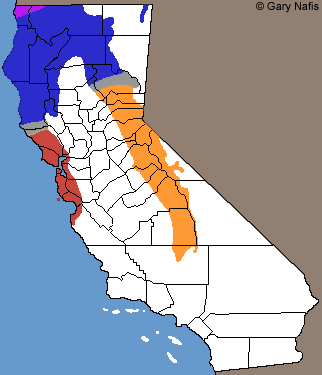|
 |
| Adult with original tail, San Mateo County |
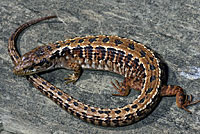 |
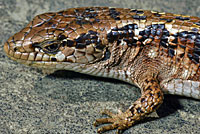 |
 |
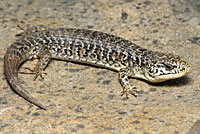 |
| Adult with mostly original tail, Marin County |
Adult, Marin County |
Adult with regenerated tail,
Mendocino County |
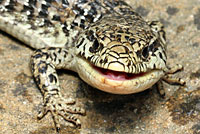 |
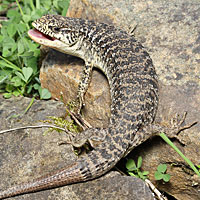 |
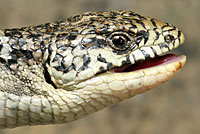 |
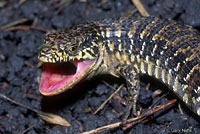 |
| Adult with regenerated tail, Mendocino County |
Adult, Contra Costa County |
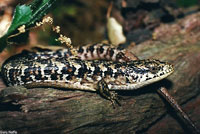 |
 |
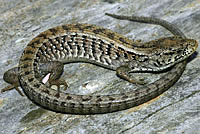 |
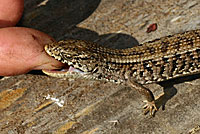 |
| Darkly-patterned adult with regenerated tail, Contra Costa County |
Adult with original tail, San Mateo County |
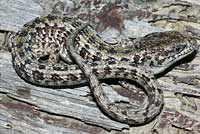 |
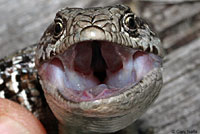 |
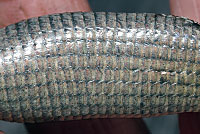 |
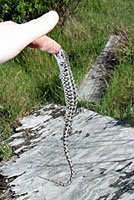 |
| Adult, Marin County with mostly original tail |
Underside of adult, Marin County
(Dark lines are between
the rows of scales) |
Sometimes these lizards will bite and hold on until you leave them alone. |
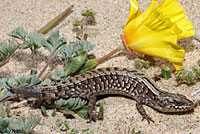 |
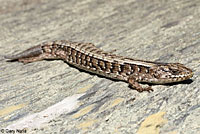 |
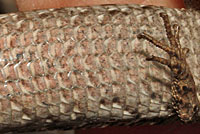 |
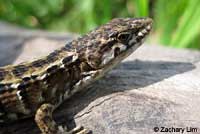 |
| Sub-adult with regenerated tail from Monterey County coastal sand dunes |
Adult, San Francisco County
© Zachary Lim |
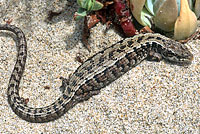 |
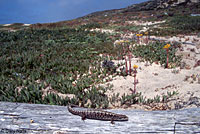 |
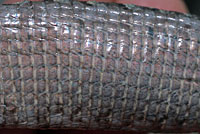 |
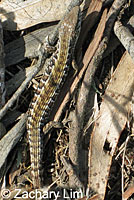 |
| Adult with original tail, from Monterey County coastal sand dunes. |
Underside of adult, Monterey County sand dunes
(Dark lines are between
the rows of scales) |
Adult, San Francisco County
© Zachary Lim |
 |
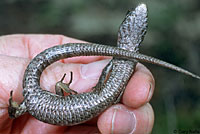 |
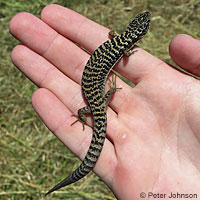 |
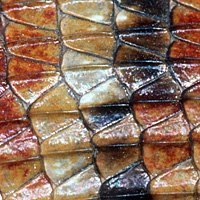 |
| Dark adult with regenerated tail from Monterey County coastal sand dunes. |
Adult from Mendocino County just north of Sonoma County, which is an intergrade area. © Peter Johnson |
Western Alligator Lizards, genus Elgaria, have large rectangular keeled scales on the back that are reinforced with bone.
(Elgaria multicarinata multicarinata is shown here). |
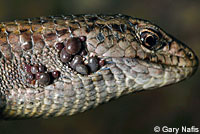 |
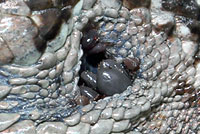 |
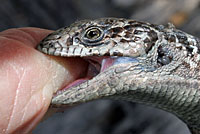 |
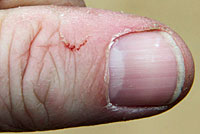 |
It is common to find blood-engorged ticks attached to alligator lizards, especially in and around the ear openings, as you can see on the Shasta Alligator Lizard on the left and on the San Francisco Alligator Lizard on the right.
|
Alligator lizards have very strong jaws with teeth
which can sometimes break the skin. |
| |
|
|
|
Juveniles |
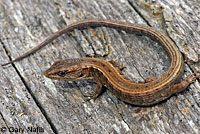 |
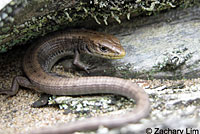 |
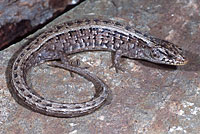 |
|
| Juvenile, Marin County |
Juvenile, San Francisco County
© Zachary Lim |
Older juvenile with partly regenerated tail from Monterey County coastal sand dunes |
|
| |
|
|
|
| Interesting Pattern and Color Variations |
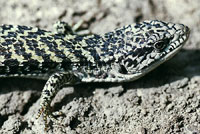 |
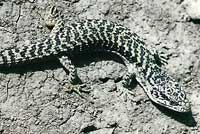 |
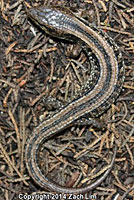 |
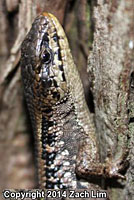 |
| Adult with mostly original tail with no brown coloring, Contra Costa County |
Adult with well-defined dark stripe on back, San Mateo County © Zach Lim |
 |
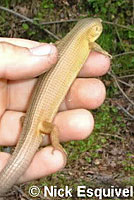 |
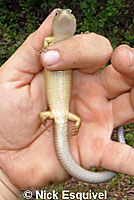 |
 |
Patternless adult (probably amelanistic) Santa Clara County. © Nick Esquivel
|
A patternless adult from Santa Cruz County. © Scott Peden |
 |
 |
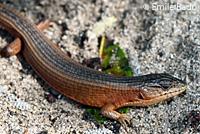 |
Partly-striped adult, Marin County
© Adam Gitmed |
The red and patternless San Francisco Alligator Lizard was found in Santa Cruz County. © Emile Bado |
| |
|
|
|
| Breeding Activity |
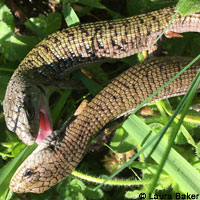 |
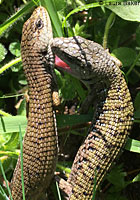 |
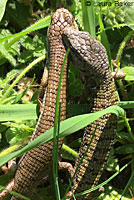 |
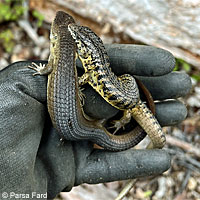 |
An adult male Alligator Lizard from the intergrade zone in northern Sonoma County
courts a female by biting onto her neck in late May. © Laura Baker |
Male courting a female, Santa Clara County © Parsa Fard |
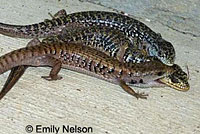 |
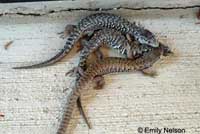 |
|
|
Two males attempting to court the same female in southern Mendocino County.
© Emily Nelson |
|
|
| |
|
|
|
| Habitat |
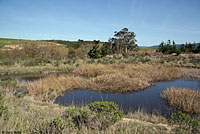 |
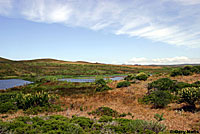 |
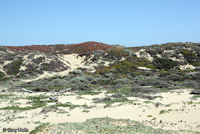 |
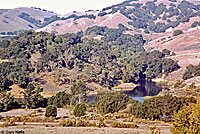 |
| Habitat, San Mateo County |
Habitat, Marin County |
Coastal dunes habitat, Monterey County |
Habitat, Contra Costa County
|
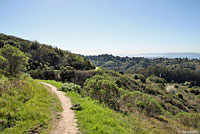 |
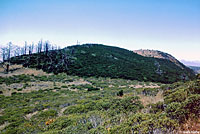 |
 |
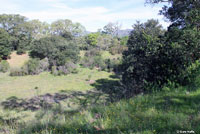 |
| Habitat, Contra Costa County |
Coastal scrub habitat, Marin County |
Habitat, Mendocino County
|
Habitat, Napa County |
| |
|
|
|
| Short Videos |
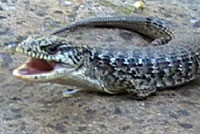 |
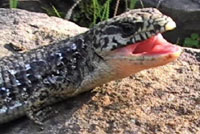 |
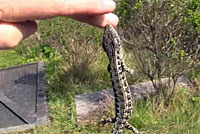 |
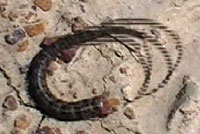 |
Disturbed from his hiding spot under a rock, an alligator lizard threatens to bite and hisses several times when he is touched.
|
A feisty alligator lizard tries to get away. |
A couple of SF alligator lizards found in Marin County, including one that bites onto a finger and won't let go. |
This video shows how an alligator lizard's tail thrashes around after it has been dropped to distract a predator. The tail moved for about 4-5 minutes, which has been cut down here to about a minute, showing several different speeds until it is just barely moving. |
|
|
|
|
| Description |
| |
| Size |
Elgaria coerulea ranges from 2 3/4 - 5 7/8 inches in length from snout to vent (7 - 13.6 cm) (Stebbins, 2003)
|
| Appearance |
Alligator lizards, genus Elgaria, are members of the family Anguidae, a family of lizards found in the Americas, Europe, Asia, and Africa.
They are characterized by a thick rounded body with short limbs and long tail.
Large bony scales, a large head on an elongated body and powerful jaws probably give the lizards their common name.
The tail can reach twice the length of its body if it has never been broken off and regenerated.
Scales are keeled on the back, sides, and legs, with 16 rows of scales across the back at the middle of the body.
(Compare with the 14 rows of scales found on the Southern Alligator Lizard - Elgaria multicarinata.)
The temporals are weakly keeled.
A band of small granular scales separates the larger bone-reinforced scales on the back and on the belly, creating a fold along each side. These folds allow the body to expand to hold food, eggs, or live young. The fold contracts when the extra capacity is not needed.
The head of a male is broader than a female's with a more triangular shape. |
| Color and Pattern |
Color is brown, gray, olive, or brown, above, with heavy dark blotches or irregular cross-bands edged with white spots.
Usually the dark bands on the back are so irregular that they cannot be counted.
Some lizards have very little pattern, appearing to have only faint dark markings.
Others have a broad stripe on the back.
The underside is yellowish or greenish.
The head is usually mottled with dark color.
Eyes
The eyes are relatively dark around the pupils compared with the light eyes of a similar species - the Southern Alligator Lizard - Elgaria multicarinata.
Lines on the Belly
Usually there are dark lines running lengthwise on the belly which run between the scales, along the edge of the scales.
(Compare with the underside lines on the Southern Alligator Lizard - Elgaria multicarinata which run through the middle of the scales.)
|
Identifying Alligator Lizards in California |
| Young |
Newborn lizards are very thin and small, roughly 4 inches long, with smooth shiny skin with a plain tan, light brown, or copper colored back and tail. The sides are darker and sometimes mottled or barred as they are on adults. Juveniles gradually develop the large scales and heavy dark barring found on the back and tails of adults.
|
| Life History and Behavior |
Activity |
Active during the day. Inactive during cold periods in winter.
Moves with a snake-like undulating motion. A good swimmer, sometimes diving into the water to escape by swimming away.
Alligator lizards are generally secretive, tending to hide in brush or under rocks, although they are often seen foraging out in the open or on roads in the morning and evening. |
| Defense |
The tail of an alligator lizard is easily broken off, as it is with many lizards.
The tail will grow back, although generally not as perfectly as the original.
A lizard may detach its tail deliberately as a defensive tactic. When first detached, the tail will writhe around for several minutes, long enough to distract a hungry predator away from the lizard.
More information about tail loss and regeneration.
Males sometimes also extrude the hemipenes when threatened.
Often when an alligator lizard is observed lying still or basking, it will tuck its legs back toward the body. This is probably a defensive measure to break up the outline of the lizard's body so that a predator can't tell that it's an animal with legs. This might be to give it the appearance of a stick or shadow or something not alive, or it might be to imitate a snake, since many animals are naturally afraid of snakes and will hesitate to approach or attack a snake.
Other defensive tactics used by alligator lizards are smearing the contents of the cloaca on the enemy and biting.
They often bite onto a predatory snake, on the neck or the head, rendering the snake unable to attack.
Samuel M. McGinnis (Stebbins & McGinnis, 2012)
reports seeing a juvenile southern alligator lizard bite onto its own tail making itself impossible to be swallowed by a juvenile Alameda Striped Racer, which eventually gave up. |
| Diet and Feeding |
| Eats a variety of small invertebrates, including slugs, snails, and worms. Will also eat small lizards and small mammals. Occasionally feed on bird eggs and young birds. (Stebbins) |
| Reproduction |
After mating, the female carries her young inside her until they are born live and fully-formed, sometime between June and September.
During the spring breeding season, a male lizard grabs on to the head of a female with his mouth until she is ready to let him mate with her. They can remain attached this way for many hours, almost oblivious to their surroundings. Besides keeping her from running off to mate with another male, this probably shows her how strong and suitable a mate he is.
|
| Habitat |
Woodland, forests, grassland, coastal chaparral, coastal dunes and marshes, under beach driftwood. Commonly found hiding under rocks, logs, bark, boards, trash, or other surface cover. Prefers wetter and cooler habitats than E. multicarinata, but generally found near sunny clearings.
|
| Geographical Range |
The subspcies Elgaria coerulea coerulea is endemic to California. It ranges from a zone of intergradation with E. c. shastensis starting in Northern Sonoma County, south along the coast to northern Monterey County. Also found on Angel, Brooks, and Yerba Buena islands in San Francisco Bay and on Ano Nuevo Island.
The species Elgaria coerulea ranges from Southern British Columbia south chiefly west of the Cascades and Coast Ranges to northern Monterey County, east into northern Idaho and northwestern Montana, with isolated populations occurring in southeastern Oregon, northwestern Nevada and the Warner Mountains in California, and south through the Sierra Nevada Mountains to Kern County.
|
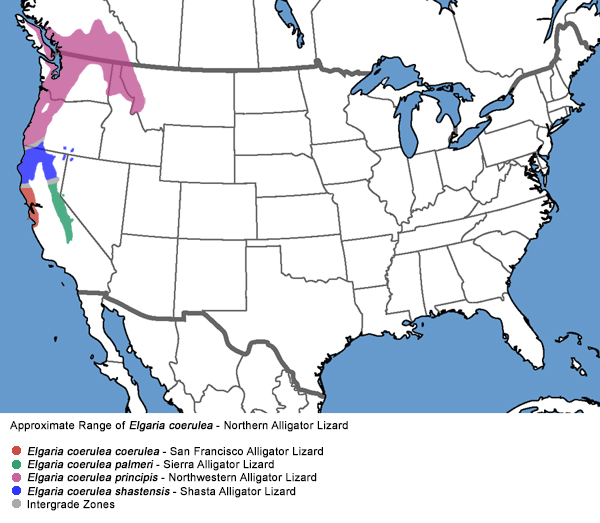
|
| Elevational Range |
Stebbins (2003) shows the elevational range of the species Elgaria coerulea as sea level to around 10,500 ft. (3,200 m.) but only the subspecies E. c. palmeri can be found that high up. The other subspecies range much lower.
|
| Notes on Taxonomy |
In 2025 the SSAR recognized only 3 subspecies of Elgaria coerulea, with E. c. principis merged into E. c. coerulea.
E. c. coerulea (synonym: E. c. principis) - Northwestern Alligator Lizard
E. c. palmeri - Southern Sierra Alligator Lizard
E. c. shastensis - Northern Sierra Alligator Lizard
"Based on mtDNA, Lavin et al. (2018, Zoologica Scripta 47: 462–476) inferred 10 non-overlapping mitochondrial clades and six population clusters within E. coerulea and based on nuclear SNPs. Leaché et al. (2024, Journal of Heredity 115: 57–71) inferred 10 population clusters and nine multi-cluster clades that are only roughly consistent with subspecies proposed by Fitch (1938, American Midland Naturalist 20: 381–424). Neither set of authors proposed taxonomic changes, although Leaché et al. (op. cit.) performed analyses that failed to support more than one species within E. coerulea.
We have re-circumscribed the subspecies to correspond to the three major clades within E. coerulea inferred by Leaché et al. (op. cit.)
E. c. coerulea (synonym: E. c. principis) is applied to the clade of Pacific Northwest, Northern California, and Northern and Southern Coast Range clusters;
E. c. palmeri is applied to the clade of Southern and two Central Sierra Nevada clusters; and
E. c. shastensis is applied to the clade of Lower Cascades and two Northern Sierra Nevada clusters.
The standard English names have been changed to reflect the geographic distributions of the taxa."
(Nicholson, K. E. (ed.). 2025 SSAR Scientific and Standard English Names List)
------------------------------------------------------------------------------------------------------------------------------------------------------------------------------------------------------------------------------
The standard English name has been changed from “San Francisco Alligator Lizard” to better reflect the distribution of this taxon."
(Nicholson, K. E. (ed.). 2025 SSAR Scientific and Standard English Names List)
------------------------------------------------------------------------------------------------------------------------------------------------------------------------------------------------------------------------------
In a study published in April, 2018 * Brian R. Lavin et al reported the results of sequencing mtDNA of Elgaria coerulea:
"Our phylogeographic examination of E. coerulea uncovered surprising diversity and structure, recovering 10 major lineages, each with substantial geographic substructure."
They did not recommend any taxonomic changes, but they did name the lineages and illustrate their distribution:
1. Pacific Northwest
2. Interior Coast Range
3. North Coast Ranges
4. South Coast Ranges
5. Northern California
6. Yolla Bolly Mountains
7. Lower Cascades
8. Central Sierra Nevada
9. Northern Sierra Nevada
10. Southern Sierra Nevada
"The taxon appears to have a Sierra Nevada origin and then moved both north and west to occupy its current distribution (as postulated 60 years ago), diversifying into a number of geographically confined clades along the way. The patterns of range limits and clade boundaries shared between E. coerulea and other codistributed forest and woodland species provides compelling evidence that a handful of major biogeographic barriers and historical events (e.g., San Francisco Bay and Monterey Bay outlets, Sierra Nevada glaciation) have been instrumental in shaping phylogeographic patterns and have likely influenced species range limits and even patterns of community assembly in the California Floristic Province."
* Brian R. Lavin, Guinivere O.U. Wogan, Jimmy A. McGuire, and Chris R. Feldman.
Phylogeography of the Northern Alligator Lizard (Squamata, Anguidae): Hidden diversity in a western endemic.
© 2018 Royal Swedish Academy of Sciences.
Zoologica Scripta. 2018; 1–15.
-------------------------------------------------------------------------------------------------------------------------------------------------------------------------------------------------------------------------------
Alternate and Previous Names (Synonyms)
Elgariai coerulea coerulea - Northwestern Alligator Lizard (Nicholson, K. E. (ed.). 2025 SSAR Scientific and Standard English Names List)
Elgaria coerulea coerulea - San Francisco Alligator Lizard (Stebbins 2003, 2012, 2018)
Gerrhonotus coeruleus coeruleus - San Francisco Alligator Lizard (Smith 1946, Stebbins 1954, 1966, 1985)
Gerrhonotus coeruleus - Coast Alligator Lizard (Gerrhonotus Burnettii; Elgaria formosa; Gerrhonotus grandis; Gerrhonotus multicarinatus, part; Gerrhonotus scincicaudus, part. Burnett's Alligator Lizard; Skink-tailed Lizard, part; Burnett's Keeled Lizard; Green-brown Lizard; Many-keeled Lizard) (Grinnell and Camp 1917)
|
| Conservation Issues (Conservation Status) |
| None |
|
|
Taxonomy |
| Family |
Anguidae |
Alligator Lizards & Allies |
Gray, 1825 |
| Genus |
Elgaria |
Western Alligator Lizards |
Gray, 1838 |
| Species |
coerulea |
Northern Alligator Lizard |
Wiegmann, 1828 |
Subspecies
|
coerulea |
San Francisco Alligator Lizard |
(Wiegmann, 1828) |
|
Original Description |
Elgaria coerulea - (Wiegmann, 1828) - Isis von Oken, Vol. 21, p. 380
from Original Description Citations for the Reptiles and Amphibians of North America © Ellin Beltz
|
|
Meaning of the Scientific Name |
Elgaria - obscure - possibly named for an "Elgar" or a pun on "alligator."
coerulea - Latin = dark colored, dark blue - referring to the dorsal color of the type specimen
from Scientific and Common Names of the Reptiles and Amphibians of North America - Explained © Ellin Beltz
|
|
Related or Similar California Lizards |
E. c. palmeri - Sierra Alligator Lizard
E. c. shastensis - Shasta Alligator Lizard
E. c. principis - Northwestern Alligator Lizard
E. multicarinata - Southern Alligator Lizard
E. panamintina - Panamint Alligator Lizard
|
|
More Information and References |
California Department of Fish and Wildlife
Hansen, Robert W. and Shedd, Jackson D. California Amphibians and Reptiles. (Princeton Field Guides.) Princeton University Press, 2025.
Stebbins, Robert C., and McGinnis, Samuel M. Field Guide to Amphibians and Reptiles of California: Revised Edition (California Natural History Guides) University of California Press, 2012.
Stebbins, Robert C. California Amphibians and Reptiles. The University of California Press, 1972.
Flaxington, William C. Amphibians and Reptiles of California: Field Observations, Distribution, and Natural History. Fieldnotes Press, Anaheim, California, 2021.
Nicholson, K. E. (ed.). 2025. Scientific and Standard English Names of Amphibians and Reptiles of North America North of Mexico, with Comments Regarding Confidence in Our Understanding. Ninth Edition. Society for the Study of Amphibians and Reptiles. [SSAR] 87pp.
Samuel M. McGinnis and Robert C. Stebbins. Peterson Field Guide to Western Reptiles & Amphibians. 4th Edition. Houghton Mifflin Harcourt Publishing Company, 2018.
Stebbins, Robert C. A Field Guide to Western Reptiles and Amphibians. 3rd Edition. Houghton Mifflin Company, 2003.
Behler, John L., and F. Wayne King. The Audubon Society Field Guide to North American Reptiles and Amphibians. Alfred A. Knopf, 1992.
Robert Powell, Roger Conant, and Joseph T. Collins. Peterson Field Guide to Reptiles and Amphibians of Eastern and Central North America. Fourth Edition. Houghton Mifflin Harcourt, 2016.
Powell, Robert., Joseph T. Collins, and Errol D. Hooper Jr. A Key to Amphibians and Reptiles of the Continental United States and Canada. The University Press of Kansas, 1998.
Bartlett, R. D. & Patricia P. Bartlett. Guide and Reference to the Turtles and Lizards of Western North America (North of Mexico) and Hawaii. University Press of Florida, 2009.
Jones, Lawrence, Rob Lovich, editors. Lizards of the American Southwest: A Photographic Field Guide. Rio Nuevo Publishers, 2009.
Smith, Hobart M. Handbook of Lizards, Lizards of the United States and of Canada. Cornell University Press, 1946.
Taylor, Emily. California Lizards and How to Find Them. Heyday, Berkeley, California. 2025.
Joseph Grinnell and Charles Lewis Camp. A Distributional List of the Amphibians and Reptiles of California. University of California Publications in Zoology Vol. 17, No. 10, pp. 127-208. July 11, 1917.
|
|
|
The following conservation status listings for this animal are taken from the July 2025 State of California Special Animals List and the July 2025 Federally Listed Endangered and Threatened Animals of California list (unless indicated otherwise below.) Both lists are produced by multiple agencies every year, and sometimes more than once per year, so the conservation status listing information found below might not be from the most recent lists, but they don't change a great deal from year to year.. To make sure you are seeing the most recent listings, go to this California Department of Fish and Wildlife web page where you can search for and download both lists:
https://www.wildlife.ca.gov/Data/CNDDB/Plants-and-Animals.
A detailed explanation of the meaning of the status listing symbols can be found at the beginning of the two lists. For quick reference, I have included them on my Special Status Information page.
If no status is listed here, the animal is not included on either list. This most likely indicates that there are no serious conservation concerns for the animal. To find out more about an animal's status you can also go to the NatureServe and IUCN websites to check their rankings.
Check the current California Department of Fish and Wildlife sport fishing regulations to find out if this animal can be legally pursued and handled or collected with possession of a current fishing license. You can also look at the summary of the sport fishing regulations as they apply only to reptiles and amphibians that has been made for this website.
This animal is not included on the Special Animals List, which indicates that there are no significant conservation concerns for it in California.
|
| Organization |
Status Listing |
Notes |
| NatureServe Global Ranking |
|
|
| NatureServe State Ranking |
|
|
| U.S. Endangered Species Act (ESA) |
None |
|
| California Endangered Species Act (CESA) |
None |
|
| California Department of Fish and Wildlife |
None |
|
| Bureau of Land Management |
None |
|
| USDA Forest Service |
None |
|
| IUCN |
|
|
|
|
